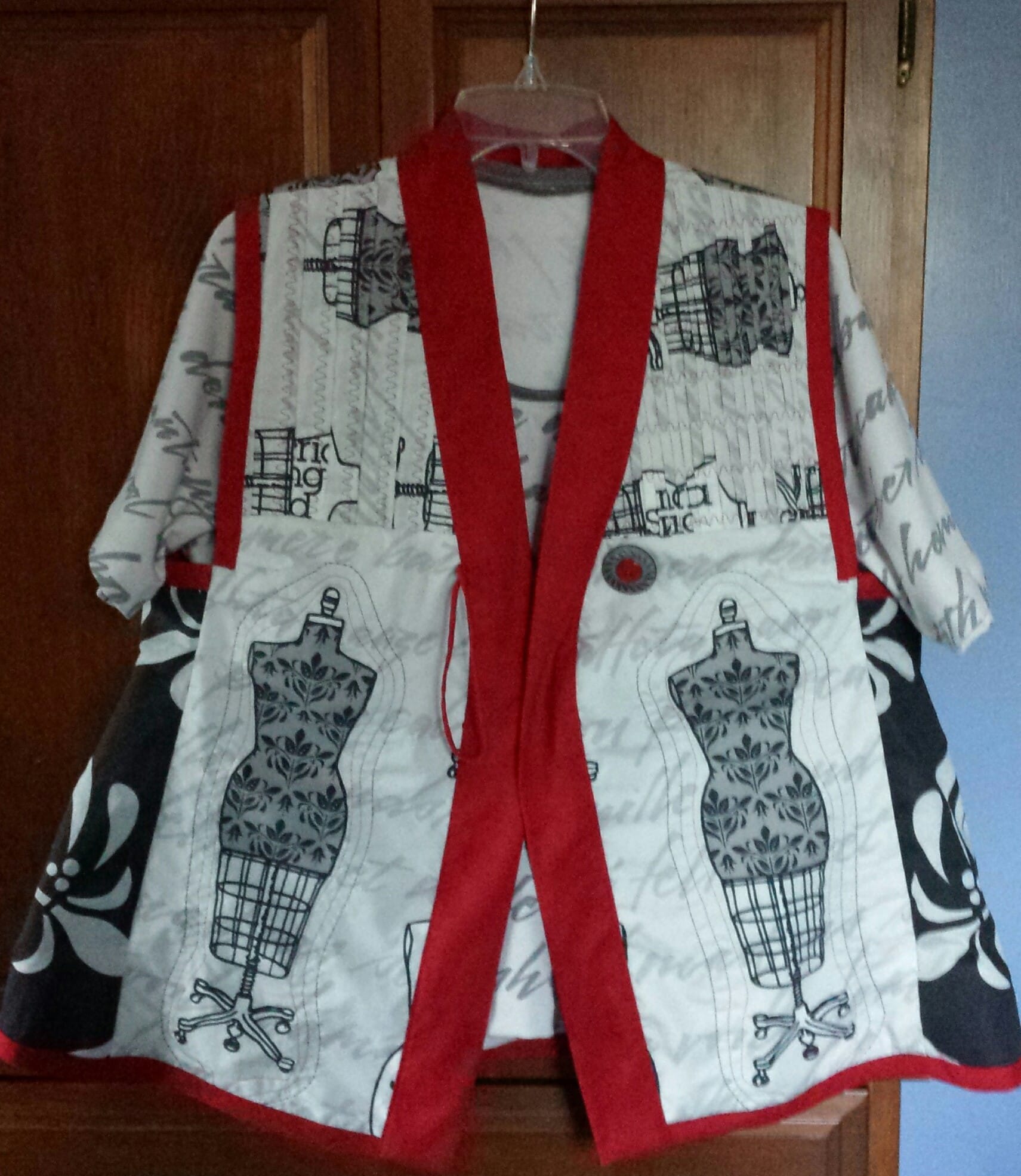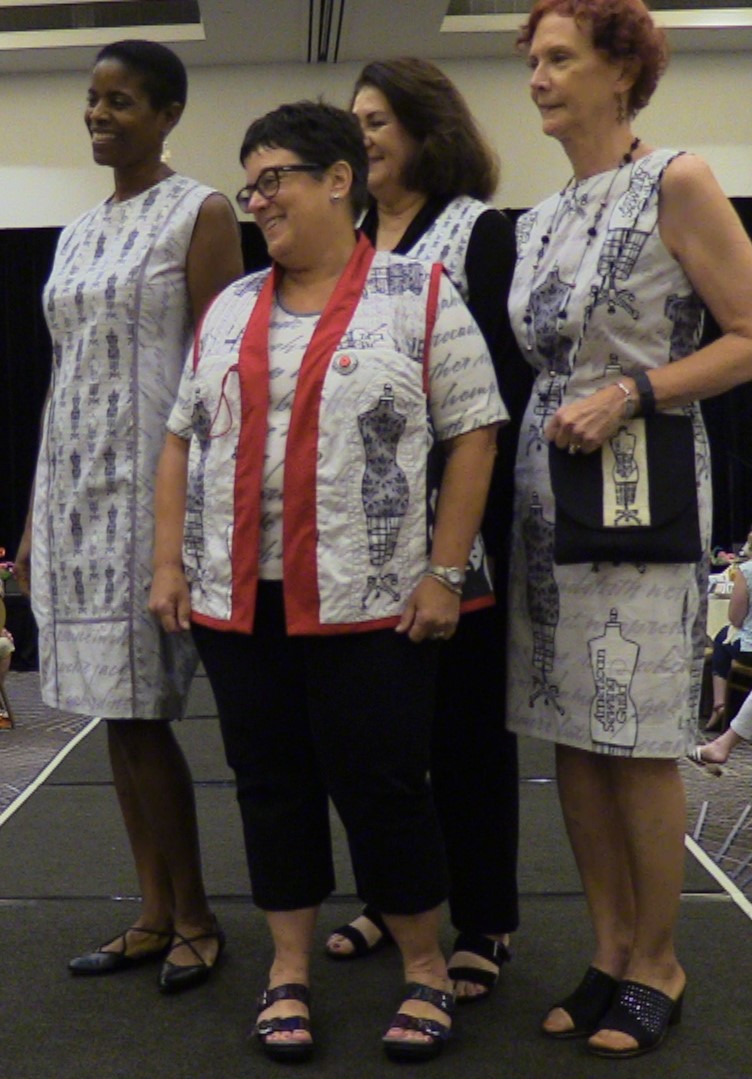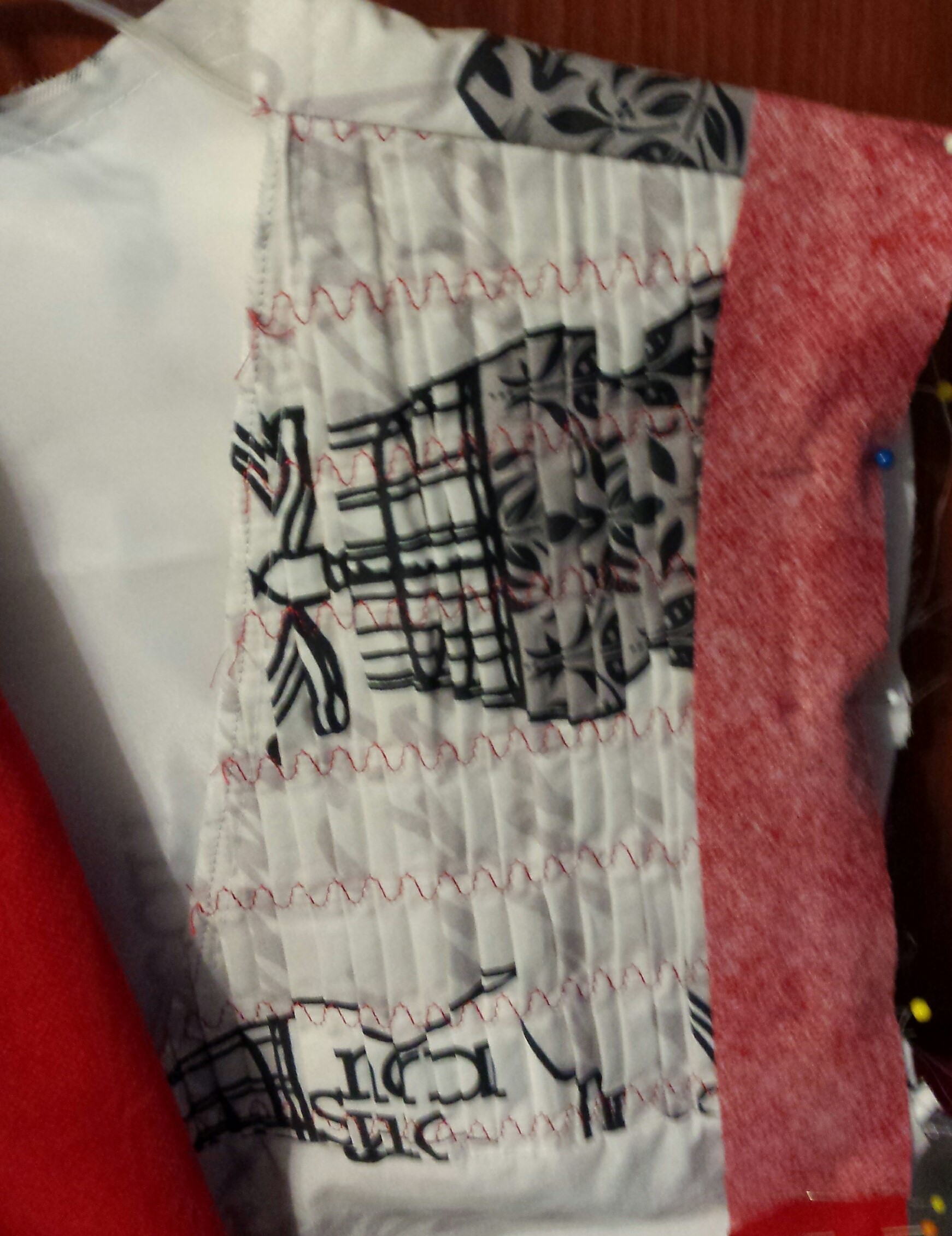
Welcome to Sew! Let’s Get Dressed, a weekly blog that encourages you to sew successfully.
Today we welcome TC Ferrito to our column. If you are in ASG you have probably met her, she is a dynamo of energy for all things sewing. We are so honored that she is also a loyal supporter of Fit for Art and is willing to share a Tabula Rasa Experience with you.
Last summer, as part of American Sewing Guild (ASG) Conference in Orlando, a group of us were charged with sewing up garments using fabrics that won the 2017 ASG Fabric Design contest. The idea was that our garments would inspire members to buy fabric and make their own items for phase 2 of the contest.
The clothes were to be worn in Orlando, in July, where it is hot and muggy. Since the fabric came in both woven and knit, I decided to make a top and a vest. My personalized Tabula Rasa patterns came to the rescue! I settled on a Tabula Rasa Knit Tee (TRK) in the grey knit print and a Tabula Rasa Jacket (TRJ), made as a vest, in 3 coordinating cottons.
How was this fabric challenging? First, it had to be ordered online from a fabric printer. We didn’t realize until after our orders were placed that we needed to choose a design scale for printing our fabric. The default scale was BIG, like couch fabric big. When it arrived, the dress forms on the fabric were huge! Much too big to flatter my short self.

So, I did what I always do when I have a sewing problem, I posted online to the sewing friends in my Buffalo ASG neighborhood group (NG) and got their input. Many of my NG friends are quilters who often work with challenging fabrics. They told me “if the fabric doesn’t work, change it or alter it in some way”.
This prompted me to look at the fabric in a different way, which led to an idea. I dug out my Perfect Pleater, remember those, and I pleated the fabric in 2 different sizes. Then I used a decorative stitch on my machine and stitched across the pleats with red rayon thread. The red thread would coordinate with the red front band, hem and armhole bindings. I sliced the front pattern and created yoke pieces then shaped the pleated sections into yokes to draw the eye to my face.

What next to make the lower sections of the vest work? Remembering back to the advice of my NG friends, I fussy cut 2 dress forms for the lower fronts and centered a complete dress form motif on the center back. Next, I cut 2 black and white coordinating florals for the side panels.
I echo stitched with black and red threads around all the dress form appliques. The red quilting cotton of the front band, armhole bands and hem binding pulled everything together. I layered a red button on top of a big antique grey button and made a red loop as a closure. It worked! So despite my initial apprehension, horror might be a better word for my reaction when I saw the size of the fabric motifs, I cleverly tamed the challenging fabric to work for me.

The TRK Tee was a totally different story and a success from the beginning. With this fabric, there was no issue of scale. The fabric is printed with fabric names in rows , cashmere, silk, wool, and more, in a pretty graphic grey script. I had some coordinating grey knit in my stash and made flat piping for the vertical seams of the tee. I also used the grey for neck binding. Since this printed text is the background of the dress form fabric too, the top worked beautifully under the vest. I have worn the top for work and play many times. It looks and feels great.
Thanks Fit for Art Patterns! Your TRJ and TRK patterns helped me take a challenging fabric and successfully design an outfit that worked for me and fit great.
Hope you are inspired by TC’s reflections on this challenging sewing experience. Are there challenging fabrics on your shelf, think creatively using your TRJ and TRK patterns to design some fun garments that will expand your Fit for Art wardrobe.
Happy Sewing, TC and RAE
Enjoy receiving our blog? Sharing is caring, so forward this post to a friend by clicking on the Forward link at the upper right corner of your e-mail notification. Remember that the beauty of the Fit for Art System is you can sew successfully with endless variations. Take a moment to review our variation patterns offered by clicking here. Also, are you following us on social media? Take a moment to check us out on Facebook and Instagram and follow the hashtag #fitforartpatterns and #sewsuccessfully.







Very interesting post! Nice to see a good adaptation with the pleating….clever idea…also the great T with a full well fitted bust. So rare to see women’s clothing that acknowledges that we have a bustline…and that we deserve some comfort. I like the piping on the T too…Thanks! I learned a couple of valuable things from this tonight!
If you know of other sewers in NH (SW of the state…Keene/Monadnock area) who like the tabula rasa patterns please let me know. I work part time at a JoAnn Store…and would really like to know more sewers inn my area.
Jeanette, We will keep our eyes and ears out for other stitchers in your area. But in the mean time, keep reading and commenting.
You know that I love the knit top and I really like it paired with the jacket. I’m adding this to my to do list.
And knowing you Glenda, you will have it done in short order!
Thanks for publishing me! I was glad to tell my story and TRJ saved the day. It’s also nice that Buffalo’s Shark Girl got into the article too. That photo is from when Rae did a jacket class in Buffalo. Notice that I am wearing a TRT there too. Once you get your pattern to fit, you can make it again and again- and it will look different every time. My TRJ is a TNT- tried and true pattern that I depend on.
Thanks TC for your energy and your good work.